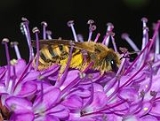
Halictus
Encyclopedia
The genus Halictus is a large assemblage of bee species in the family Halictidae
. The genus is divided into 15 subgenera, containing well over 300 species, primarily in the Northern Hemisphere
(a few species occur in South America
and Africa
). Most species are black or dark brown, sometimes metallic greenish-tinted, with apical
whitish abdominal
bands (the related genus Lasioglossum
, which is otherwise often similar in appearance, has the abdominal hair bands located basally, not apically).
Many species in the genus are eusocial, with colony size
s range from very small (2-4 bees) to large (>200). Nests are typically underground burrows, with several ovoid "cells" in which pollen
mixed with nectar is provided as food for the developing larvae; a single egg is laid on a pollen mass, and the cell is sealed. Sometimes the cells are arranged in clusters resembling a honeycomb
, but constructed of soil rather than beeswax
.
A few species in the genus have extensive geographic distribution, such as Halictus rubicundus
, which spans virtually the entire Northern Hemisphere, and Halictus ligatus, which ranges from Canada
to Venezuela
. Common Europe
an species include Halictus quadricinctus and Halictus sexcinctus.
Halictidae
Halictidae is a cosmopolitan family of the order Hymenoptera consisting of small to midsize bees which are usually dark-colored and often metallic in appearance...
. The genus is divided into 15 subgenera, containing well over 300 species, primarily in the Northern Hemisphere
Northern Hemisphere
The Northern Hemisphere is the half of a planet that is north of its equator—the word hemisphere literally means “half sphere”. It is also that half of the celestial sphere north of the celestial equator...
(a few species occur in South America
South America
South America is a continent situated in the Western Hemisphere, mostly in the Southern Hemisphere, with a relatively small portion in the Northern Hemisphere. The continent is also considered a subcontinent of the Americas. It is bordered on the west by the Pacific Ocean and on the north and east...
and Africa
Africa
Africa is the world's second largest and second most populous continent, after Asia. At about 30.2 million km² including adjacent islands, it covers 6% of the Earth's total surface area and 20.4% of the total land area...
). Most species are black or dark brown, sometimes metallic greenish-tinted, with apical
Apex
Apex may refer to:- Biology :* Apex , the tip of the spire of the shell of a gastropod* Apex is the Apical meristem or its remnant on a flower...
whitish abdominal
Abdomen
In vertebrates such as mammals the abdomen constitutes the part of the body between the thorax and pelvis. The region enclosed by the abdomen is termed the abdominal cavity...
bands (the related genus Lasioglossum
Lasioglossum
The sweat bee genus Lasioglossum is the largest of all bee genera, containing over seventeen hundred species in numerous subgenera worldwide. They are highly variable in size, coloration, and sculpture; among the more unusual variants, some are cleptoparasites, some are nocturnal, and some are...
, which is otherwise often similar in appearance, has the abdominal hair bands located basally, not apically).
Many species in the genus are eusocial, with colony size
Group size measures
Many animals, including humans, tend to live in groups, herds, flocks, bands, packs, shoals, or colonies of conspecific individuals. The size of these groups, as expressed by the number of participant individuals, is an important aspect of their social environment...
s range from very small (2-4 bees) to large (>200). Nests are typically underground burrows, with several ovoid "cells" in which pollen
Pollen
Pollen is a fine to coarse powder containing the microgametophytes of seed plants, which produce the male gametes . Pollen grains have a hard coat that protects the sperm cells during the process of their movement from the stamens to the pistil of flowering plants or from the male cone to the...
mixed with nectar is provided as food for the developing larvae; a single egg is laid on a pollen mass, and the cell is sealed. Sometimes the cells are arranged in clusters resembling a honeycomb
Honeycomb
A honeycomb is a mass of hexagonal waxcells built by honey bees in their nests to contain their larvae and stores of honey and pollen.Beekeepers may remove the entire honeycomb to harvest honey...
, but constructed of soil rather than beeswax
Beeswax
Beeswax is a natural wax produced in the bee hive of honey bees of the genus Apis. It is mainly esters of fatty acids and various long chain alcohols...
.
A few species in the genus have extensive geographic distribution, such as Halictus rubicundus
Halictus rubicundus
Halictus rubicundus is a species of sweat bee found throughout the Northern Hemisphere. It is small , dark brown, with fine white bands across the apices of the abdominal segments. The legs are often somewhat reddish...
, which spans virtually the entire Northern Hemisphere, and Halictus ligatus, which ranges from Canada
Canada
Canada is a North American country consisting of ten provinces and three territories. Located in the northern part of the continent, it extends from the Atlantic Ocean in the east to the Pacific Ocean in the west, and northward into the Arctic Ocean...
to Venezuela
Venezuela
Venezuela , officially called the Bolivarian Republic of Venezuela , is a tropical country on the northern coast of South America. It borders Colombia to the west, Guyana to the east, and Brazil to the south...
. Common Europe
Europe
Europe is, by convention, one of the world's seven continents. Comprising the westernmost peninsula of Eurasia, Europe is generally 'divided' from Asia to its east by the watershed divides of the Ural and Caucasus Mountains, the Ural River, the Caspian and Black Seas, and the waterways connecting...
an species include Halictus quadricinctus and Halictus sexcinctus.

